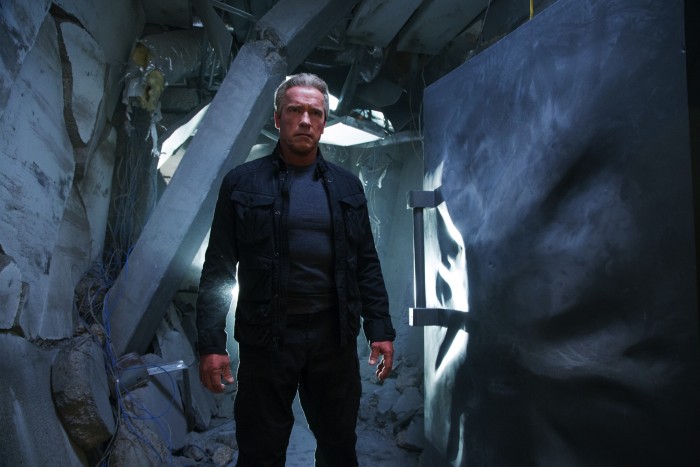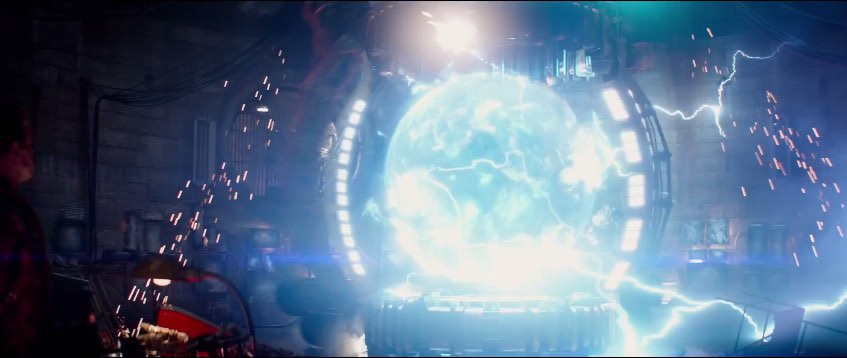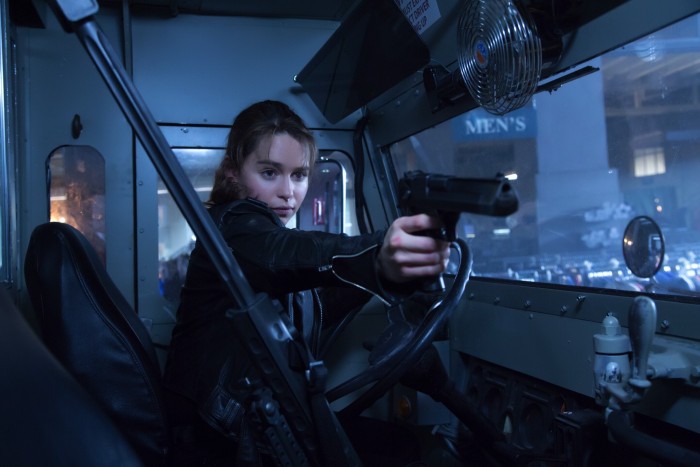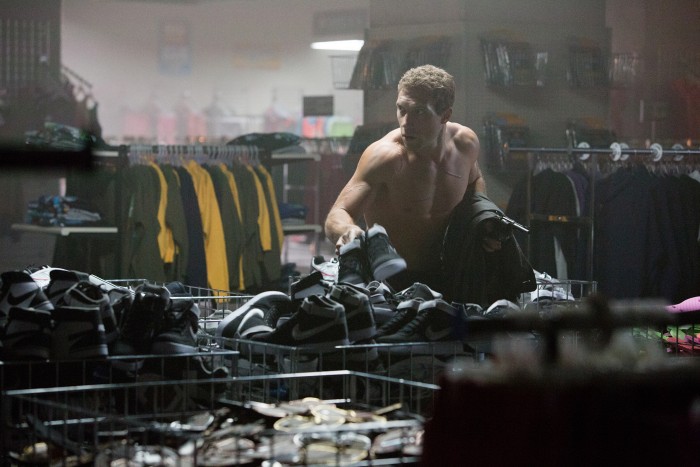40 Things We Learned On The Set Of 'Terminator: Genisys'
On July 11th 2014, I traveled to New Orleans to visit the set of Terminator Genisys, the fifth installment of the Terminator film franchise. My visit to the set of McG's Terminator Salvation four years prior couldn't have been more different than my experience on the latest installment.
Salvation director McG had talked up Jonathan Nolan's script (right on the heels of The Dark Knight's release). He showed us a ton of practical creations designed by Stan Winston's Legacy Effects; we explored gritty lived in sets made out of dilapidated buildings in Albuquerque, saw a room of cool concept art, and we watched Christian Bale film a "should have been" iconic scene. But of course, it wasn't a remembered moment — because the film was widely panned by critics and fans alike.
On the other hand, my visit to the Terminator Genisys set could not have been more the opposite: the sound stages were lined wall to wall with giant green screens, we saw no endoskeletons, and we saw no animatronic puppets. Instead we watched Arnold Schwarzenegger walk across the set for a "walk and talk" scene late in the film. Instead of a full on-assault to convince us this was going to be cool, we were met with a low-key, more confident and assured presentation from everyone involved.
We know how Terminator Salvation turned out; will this be any different? I'll be completely honest, I was way more impressed with what I saw on the set of Terminator Salvation, but that might be because the crew of Terminator Genisys seemed much more guarded — their plan not only involved this film, but a trilogy of movies. Despite being very cagey with details, all of the people we talked to seemed much more confident this time around. What I can tell you is what I learned while on set. Read out Terminator Genisys set visit after the jump.
The Planned Trilogy
This will be the first film of a new trilogy that will allow for "deeper drops of resonance that are only possible in a longer story told over three films."
The producers are looking at this film and the two sequels to follow as a completely standalone trilogy.
They had broken down the story for the three films prior to production.
Miles Dyson's son will play a big part of the second film of the trilogy.
They plan to shoot parts two and three of the trilogy back to back. They are planning 9 months of continuous shooting for both of the sequels.
Time Displacement Machines
The movie will feature three different versions of the time displacement machines, sometimes referred to as TDMs. The TDMs in the movie appear in the years 1984, 2017 and 2029. Each TDM looks very distinct because of who created them and the fact they were created in the times in which they appear, with currently-available technology.
The film will take place in multiple time periods: 1984, 1995, and 2029, with no one time period dominating the screen time. The movie will ask the question: what can and can't be changed in time?
The 1984 Time Displacement Machine was created by the Terminator. It is created of found parts jerry-rigged together, with two sets of arms that spin opposite each other. The electromagnetic-looking machine is hidden in an old sewer system which has walls lined with refrigeration units. The set took 2 months to design and 6 weeks to build.
The time machines in the movie are designed using electromagnetic fields, which is apparently a big story point. The perfect electromagnetic field requires refrigeration to function which is why the 1984 TDM set is lined with refrigeration devices.
Story
The original Terminator film was influenced by the Cold War paranoia of nuclear holocaust. Today is a different world — we can't wait to get the latest technology, and Skynet has put it into everyone's hands. Consumers are not only willing to buy, they wait in lines around the block for the latest piece of tech from the company.
Terminator: Genisys will dig deeper into the subject of the singularity. Big companies like Apple and Google are already focusing on wearables, and the next step is bionic implants. Bonding man and machine is right around the corner, and this is a comment on our society and where we are headed. Genisys is a commentary on the amount of trust we put in machines, and in the technology we love. Freedom and free will are what is terrifying in this film.Terminator: Genisys was described as not a traditional remake or a continuation or a sequel, but more of a reimagining — kind of like JJ Abrams' Star Trek. The film will allow moviegoers to experience the story we have already seen, but in a different way. The story features a divergent timeline that goes off an entirely different direction, and taking is down a road we've never been on before. This is not a direct sequel, there is no straight line from A to B.
There will be fun references and hidden gags for fans of the first two Terminator films. For example, some of the familiar wardrobe will be featured in the new film. Costume designer Susan Matheson went on a long journey to get the exact Nike sneaker Kyle Reese wears in The Terminator. Two months before starting on the movie she began looking for the sneakers. She went on eBay but every set was used and didn't look new. She began hounding Nike but they wanted her to design using their ID custom sneaker system, and the sneaker wouldn't look the same. So she ended up talking to Paramount and begged them to make it happen. Nike responded by stopping their production line and making 25 pairs of the original sneaker from the original film. Jai said he wants to keep a pair of his character's Nikes after the shoot.
This movie very specifically uses James Cameron's vision as it's source material, while not discounting the other two films. Director Alan Taylor described it best as the "first two films are our compass, inspiration and our guide." All of the cast and crew referenced the first and second Terminator films but not the others. Its not that they are pretending the other films didn't happen, but the story is based more on the first two installments. Taylor felt the main tension of the series was lost once the stories started being set more in the future. Arnold says they are ignoring the last movie almost entirely.
We will see moments that fans will recognize, but not remakes of those moments. Jason Clarke thinks Laeta Kalogridis and Patrick Lussier really got the script right, honoring the franchise we know yet making it feel new. He compared the movie to Dawn of the Planet of the Apes, which was opening in theaters the day we were on set, saying they brought real intelligence and respect to the script.
The first movie was ultimately a love story, the second film was a father/son story, the third and fourth are more complicated. This film doesn't have the remarkable simplicity of the first two films but is designed to have a tighter core. Director Alan Taylor says that the first film was a horror movie, the second film is a thriller, and this movie is a dysfunctional family story: Mirroring father figures in this with a love story at the core and the issue of family.
The theme of the movie has to do with what we give and take from this world and what responsibility it holds.
Terminator: Genisys begins in the year 2029, the same place the first Terminator film starts, with John Connor sending Kyle Reese back to protect his mother. But this is not a remake of that first Terminator film — something is different and things don't play out as expected once Arnold gets to 1984.
We will see how the world comes to an end as the machines start to take over.
Characters
This film is more of an ensemble story than the previous Terminator stories. The characters are the same people we know but they have been shaped by different circumstances. Not one of the four characters has the same opinion about another character.
Jason Clarke plays an older John Connor in this film. He watched Eddie Furlong's performance as young John Connor in Terminator 2: Judgement Day and used it to help create his own performance. Clarke says John Connor in this is different because it is completely believable, it is a developed character and not just a character type. We will finally see John Connor own the role of the chosen one.
Kyle Reese, played by Jai Courtney in this movie, is John Connor's right hand man but their relationship is obviously very complicated as they are now working together while aware they are also father/son. The script doesn't dance around the circumstances and plays with that new dynamic. Courtney revisited the previous films but just for context — he doesn't try to replicate Michael Biehn or Anton Yelchin's performances.
Arnold Schwarzenegger is playing a version of the classic T-800 from a timeline we've never seen and in a way we've never seen. He's spent a lot of time with Sarah Connor already. On set and in the script Arnold's character is referenced as "Guardian" but the nickname was only for behind-the-scenes production use. It's his job in this film to protect Sarah Connor and to destroy anything that comes in his way.
The T-800 will wear leather. Since he travels to different times there are different outfits and at least two of them will involve leather and some of the choices will be very different.
Emilia Clarke plays Sarah Connor in the new film. She first watched the Terminator films when her older brother forced her watch them as a kid. She ended up loving the series and now her brother is so envious that she's now part of the franchise's legacy.JK Simmons plays a character named O'Brien.
Production
Terminator: Genisys was filming at the NASA Michoud Assembly Facility in New Orleans alongside Jurassic World. (We saw many signs using that film's working title "Ebb Tide"). We needed to get special clearances to visit the set, and the check-in process to enter the grounds was unlike anything I've ever seen before on a set visit. This NASA facility is where they built the space shuttles. Now the giant buildings are rented out as huge soundstages for Hollywood films.Terminator: Genisys was filming under the working code name "Vista." Some people on set have theories on what the working title "Vista" means, while others just think it's a reference to Arnold's signature "Hasta la vista" line.
We saw them film on a stage with a giant 2017 Cyberdine set, filled with robotic arms like you see in car plants. A "Genisys" program could be seen running on a computer screen. A gigantic green screen surrounded the set. At the center was a circular tower with copper colored tubing; that's one of the time displacement devices. The scene we watched was from the third act of the film, which involves Sarah Connor, Kyle Reese and the Terminator trying to blow up Cyberdine. They discover some secret things going on in Cyberdine while they plant bombs. The scene involves Arnold, Sarah and Connor walking up a set of stairs and across a walkway in Cyberdine as Arnold explains exposition. They walk past the time displacement device and Arnold comments that they can only use it once. The T-800 says something about having worked at Cyberdine.
Arnold went through two and a half hours of prosthetics on the day we visited, which is a scene near the end of the story so the T-800 is more battle-damaged. He had metal pieces protruding from his face and two big green areas which will be filled in by a CG endoskeleton.
They had to shoot Cyberdine on the NASA stage because there wasn't any other place in Louisiana tall enough to hold the set.
Video game developers were on set for the few days prior to my visit, in order to get all the details right for whatever video game they are developing alongside the movies.
Terminator: Genisys was shot over 90 first unit days.
They are shooting the film in high definition, but not in 3D.
The producers claimed that they don't know for sure if the movie will be rated R or PG-13, and that the filmmakers will find out in post.
They shot in San Francisco, including some pre-Judgement Day stuff on the beach.
Costume designer Susan Matheson wanted the world to feel real, gritty and interesting — a lived in dirty world. She repurposed California license plates and tires as protective gear for the knees and shoulders — the gear the people of this world wear either exists or was repurposed from parts available. Matheson did research on gorilla fighters in the world today, and found that most repurpose what's available. Everything is covered in post apocalyptic grey dust. She referenced the culture of Los Angeles in the wardrobe scrounged together in the post apocalyptic Los Angeles scenes — something that hasn't been done in the future worlds of the other films. Every aspect of Los Angeles culture is featured in the movie, even if you can't see it in the background. The arm pieces and shoulder pieces of the future fighters are rubber car mats, chopped up, aged in a cement mixer, ripped up and combined. In the end they cost about $10 rather than hundreds or thousands of dollars. This is an example of how budget constraints ended up improving the film's production.
We saw some weapons in the prop department: An Endo cannon that was used by the endoskeleton in the future war which was designed to look like a weapon that a machine would design. The cannon shoots plasma and lights up red. John Connor has a gun based on an AK47, modified on an existing gun so it can fire blanks and get a real recoil effect. Both guns have circular canisters which holds the plasma. Sarah Connor has a Grenade launcher to fire during one action sequence.



